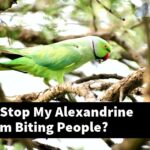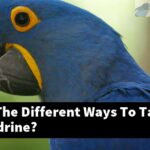Determining the age of an Alexandrine parrot can be quite challenging, as they don’t show drastic changes in their appearance as they age.
However, there are a few subtle differences in their physical features, behavior, and molting patterns that can give us a clue about their age.
In this article, I will explore these signs and how to use them to estimate the age of your Alexandrine parrot.
Table of Contents
Physical Features
Feather Colors
Young Alexandrine parrots, under a year old, tend to have more vibrant and green colors on their feathers. As they grow older, their colors become slightly duller. Adult males may develop a black and pink ring around their necks, while females have a lighter grayish ring.
Eye Color
Another subtle difference in physical appearance is the color of their eyes. Juvenile Alexandrine parrots have dark, almost black eyes. As they mature, the eyes gradually lighten to a yellow or pale orange hue.
Beak and Feet
The beak and feet of younger Alexandrine parrots tend to be a light pink color. With age, these parts become darker, eventually turning into a dark reddish-brown color.
Behavioral Signs
Vocalizations
Alexandrine parrots are known for their ability to mimic sounds and human speech. Younger birds may have limited vocabulary and may not mimic as much as older, more experienced birds. As they age, their vocalizations become more diverse and complex.
Interaction with Humans
Younger Alexandrine parrots are generally more curious and open to interacting with humans. They may be more likely to approach you and seek your attention. On the other hand, older birds may be more cautious or even territorial, especially if they have not been socialized properly.
Territorial Behavior
Adult Alexandrine parrots tend to be more territorial than juveniles. Males, in particular, may become more aggressive towards other birds or humans when they reach sexual maturity, which usually occurs around 3 years of age.
Matiniy 2 Pcs Pirate Parrot on Shoulder Life Sized Artificial Parrot Toy for Costume Dress-up Accessory for Halloween Party(Multicolor)
$14.99 (as of 05/12/2025 03:19 GMT +03:00 - More infoProduct prices and availability are accurate as of the date/time indicated and are subject to change. Any price and availability information displayed on [relevant Amazon Site(s), as applicable] at the time of purchase will apply to the purchase of this product.)Bird Toys, Parrot Toys for Large Birds,Natural Corn cob and Loofah Slices Bird chew Toys for African Grey Parrots, Macaws, Cockatoos, Amazon Parrot and other Small and Medium-Sized Parrot (Colorful)
$12.97 ($12.97 / count) (as of 05/12/2025 05:59 GMT +03:00 - More infoProduct prices and availability are accurate as of the date/time indicated and are subject to change. Any price and availability information displayed on [relevant Amazon Site(s), as applicable] at the time of purchase will apply to the purchase of this product.)Kaytee Fiesta Parrot Food, Nutritious and Fun Blend, Supports Skin, Feather, Digestion, Brain and Heart Health, 4.5 pounds
16% OffMolting Patterns
Frequency of Molting
All birds go through a molting process where they shed their old feathers and grow new ones. For Alexandrine par parrots, this process usually occurs once or twice a year. Juvenile parrots may have more frequent molting, while adult birds typically molt less often.
Molting Stages
Juvenile Stage
During the juvenile stage, Alexandrine parrots will go through several molts as they grow and develop. These early molts may be more noticeable, with a significant amount of feather loss and regrowth.
Adult Stage
As the parrot reaches adulthood, molting becomes less frequent and less dramatic. The adult feathers are more stable and may not show as much change during the molting process.
Alexandrine Parrot Lifespan
Lifespan
Alexandrine parrots have an average lifespan of 25 to 30 years in captivity, though some can live up to 40 years with proper care. Understanding your parrot’s age can help you provide appropriate care and monitor their health throughout their life.
Factors Affecting Lifespan
Diet
A well-balanced diet is crucial for the overall health and longevity of your Alexandrine parrot. Feeding them a mix of high-quality pellets, fresh fruits, vegetables, and occasional treats can help ensure they receive all the necessary nutrients.
Environment
Creating a safe and comfortable living environment for your parrot is essential for their well-being. A spacious cage, proper lighting, and maintaining a consistent temperature can all contribute to a longer, healthier life for your bird.
Enrichment and Mental Health
Mental stimulation and social interaction are vital for the happiness and longevity of your Alexandrine parrot. Providing toys, puzzles, and opportunities for socialization with humans or other birds can help keep their minds sharp and reduce stress.
Expert Assistance
Avian Veterinarians
Consulting with an experienced avian veterinarian is one of the best ways to determine the age of your Alexandrine parrot. They can assess your bird’s physical and behavioral signs, as well as provide guidance on proper care for their specific age.
Bird Clubs and Enthusiast Communities
Connecting with fellow parrot enthusiasts through bird clubs or online forums can provide valuable insights and advice on estimating your Alexandrine parrot’s age. Sharing experiences and knowledge with others can help you better understand your bird and its needs.
Conclusion
Determining the age of an Alexandrine parrot is not an exact science, but by observing their physical features, behavior, and molting patterns, you can make an educated guess. Consult with experts and fellow parrot enthusiasts for additional guidance, and always provide the best care possible to ensure your parrot lives a long, healthy life.
FAQs
- At what age do Alexandrine parrots reach sexual maturity? Alexandrine parrots typically reach sexual maturity around 3 years of age.
- What is the average lifespan of an Alexandrine parrot in captivity? In captivity, Alexandrine parrots have an average lifespan of 25 to 30 years, with some living up to 40 years if given proper care.
- How often do Alexandrine parrots molt? Alexandrine parrots usually molt once or twice a year, with younger birds molting more frequently than adults.
- Do male and female Alexandrine parrots have different physical features? Yes, adult male Alexandrine parrots develop a black and pink ring around their necks, while females have a lighter grayish ring.
- What factors contribute to the lifespan of an Alexandrine parrot? Factors that affect an Alexandrine parrot’s lifespan include diet, environment, enrichment, mental health, and proper veterinary care.
























